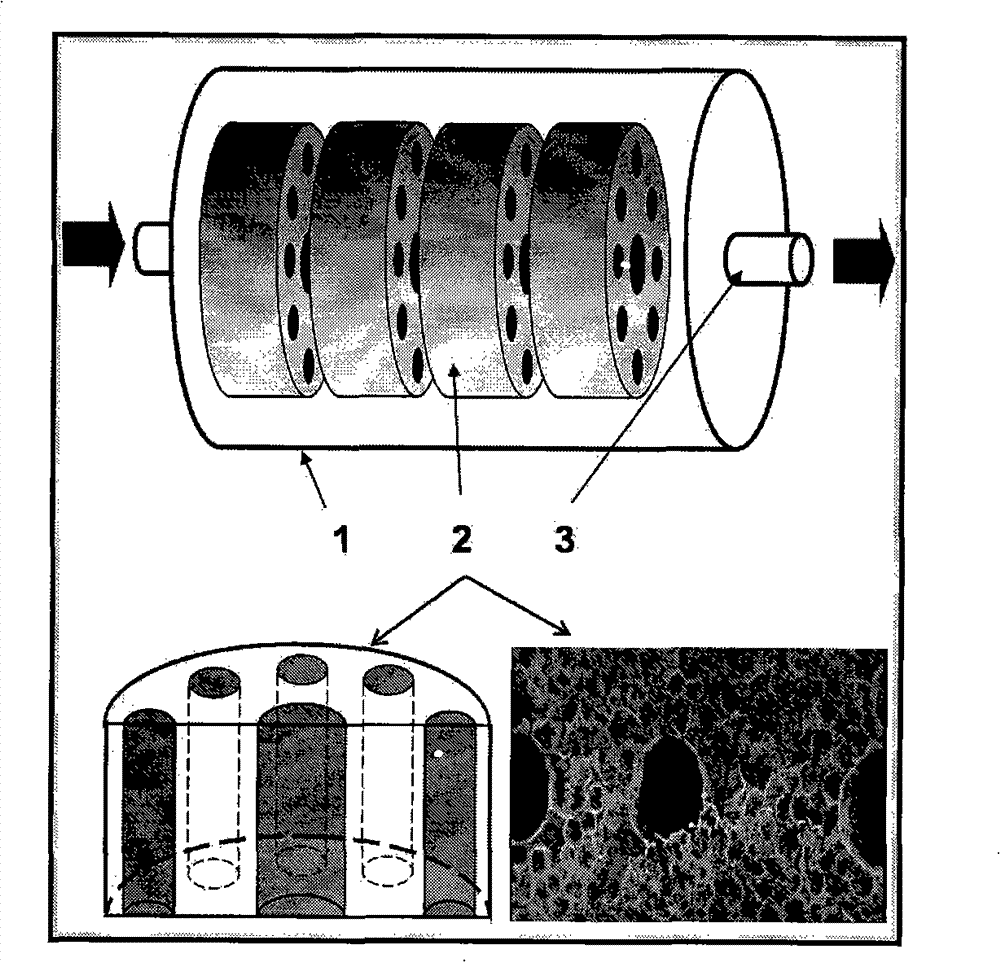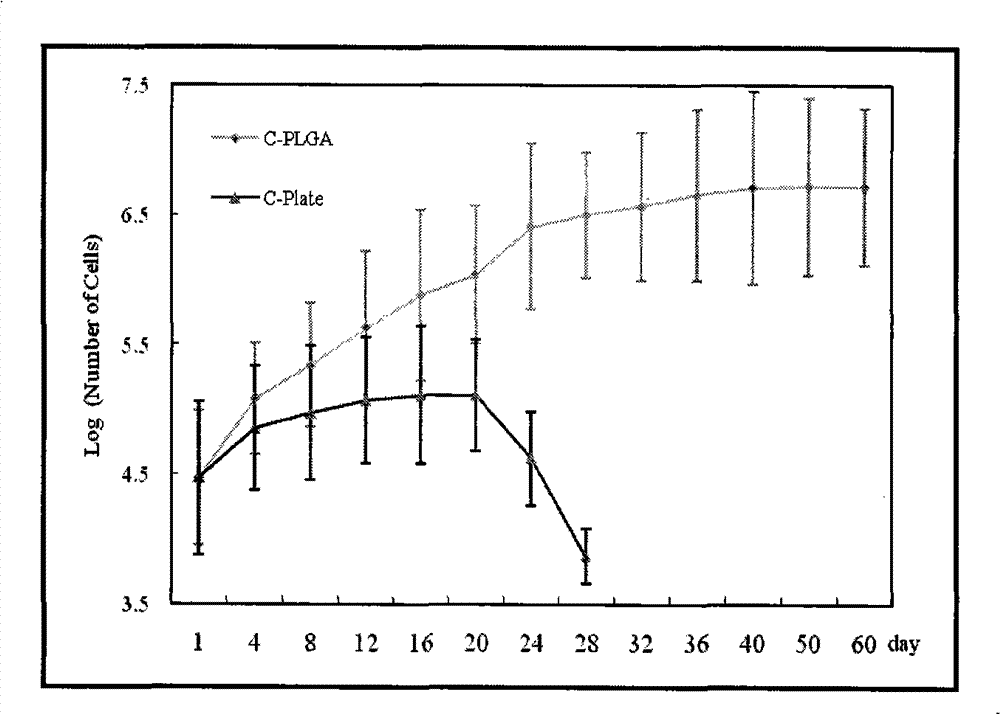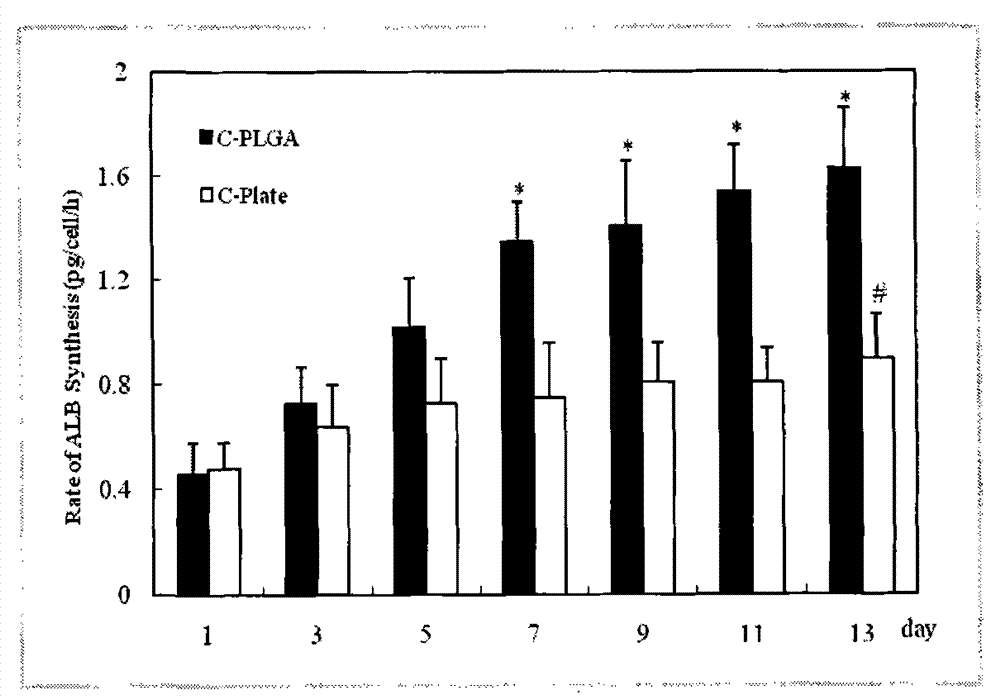Implantation type artificial hepar
An implantable and artificial technology, applied in the fields of clinical medicine, biomedicine and regenerative medicine, can solve the problems of lack of biological correspondence and the inability of implanted cells to eventually replace organ function, so as to promote angiogenesis, promote long-term survival and function. , the effect of strong tissue regeneration
- Summary
- Abstract
- Description
- Claims
- Application Information
AI Technical Summary
Problems solved by technology
Method used
Image
Examples
specific Embodiment 1
[0025] Specific Example 1 (Comparison of Implantable Artificial Liver and Monolayer Adhesive Culture Rat Hepatocytes)
[0026] The polyglycolic acid or polylactic acid glycolic acid envelope 1 is 15 mm long, and the material of the three-dimensional porous support 2 is PLGA, and the molecular weight of PLGA is 70,000 units. The porous scaffold 2 has a diameter of 9mm, a thickness of 3mm, and a pore diameter of 100-200nm. It is provided with a specific lumen (the lumen structure is a circular lumen with a pore diameter of 200-500nm, which is directly laser-drilled in a three-dimensional stent. Without other materials, it is mainly used to provide endothelial cell growth and induce microangiogenesis.) 6-8 pieces, with a pore size of 400nm, stacked with 2 pieces of 4 porous scaffolds. Polyglycolic acid or polylactic-glycolic acid tube seal 3 diameter 2 mm.
[0027] Rat primary hepatocytes obtained by conventional separation, with 10 7 The cells / ml density was inoculated into th...
specific Embodiment 2
[0035] Specific Example 2 (Comparison of Implantable Artificial Liver and Monolayer Adhesive Differentiation Rat Bone Marrow Mesenchymal Stem Cells (BMSCs) to Hepatocytes)
[0036] The polyglycolic acid or polylactic acid glycolic acid envelope 1 is 15 mm long, and the material of the three-dimensional porous support 2 is PLGA, and the molecular weight of PLGA is 70,000 units. The porous scaffold 2 has a diameter of 9mm, a thickness of 3mm, and a pore diameter of 100-200nm. There are 6-8 specific lumens with a pore diameter of 400nm. Four porous scaffolds 2 are stacked. Polyglycolic acid or polylactic-glycolic acid tube seal 3 diameter 2 mm.
[0037] Rat BMSCs obtained by conventional isolation were pressed by 10 7 The cells / ml density was inoculated into the IMDM (purchased from Invitrogen) medium containing hepatocyte growth factor, and the cells were injected into the PLGA three-dimensional porous scaffold with a syringe, and the amount of cells per scaffold was 10 6 The ...
specific Embodiment 3
[0046] Specific embodiment 3 (implantation type artificial liver and direct injection method carry out the comparison of cell transplantation treatment AHF rat)
[0047] The polyglycolic acid or polylactic acid glycolic acid envelope 1 is 15 mm long, and the material of the three-dimensional porous support 2 is PLGA, and the molecular weight of PLGA is 70,000 units. The porous scaffold 2 has a diameter of 9mm, a thickness of 3mm, and a pore diameter of 100-200nm. There are 6-8 specific lumens with a pore diameter of 400nm. Four porous scaffolds 2 are stacked. Polyglycolic acid or polylactic-glycolic acid tube seal 3 diameter 2 mm.
[0048] Rat BMSCs obtained by conventional isolation were pressed by 10 7 The cells / ml density was inoculated into the IMDM (purchased from Invitrogen) medium containing hepatocyte growth factor, and the cells were injected into the PLGA three-dimensional porous scaffold with a syringe, and the amount of cells per scaffold was 10 6 cells. Centrif...
PUM
| Property | Measurement | Unit |
|---|---|---|
| diameter | aaaaa | aaaaa |
| length | aaaaa | aaaaa |
| diameter | aaaaa | aaaaa |
Abstract
Description
Claims
Application Information
 Login to View More
Login to View More - R&D
- Intellectual Property
- Life Sciences
- Materials
- Tech Scout
- Unparalleled Data Quality
- Higher Quality Content
- 60% Fewer Hallucinations
Browse by: Latest US Patents, China's latest patents, Technical Efficacy Thesaurus, Application Domain, Technology Topic, Popular Technical Reports.
© 2025 PatSnap. All rights reserved.Legal|Privacy policy|Modern Slavery Act Transparency Statement|Sitemap|About US| Contact US: help@patsnap.com



